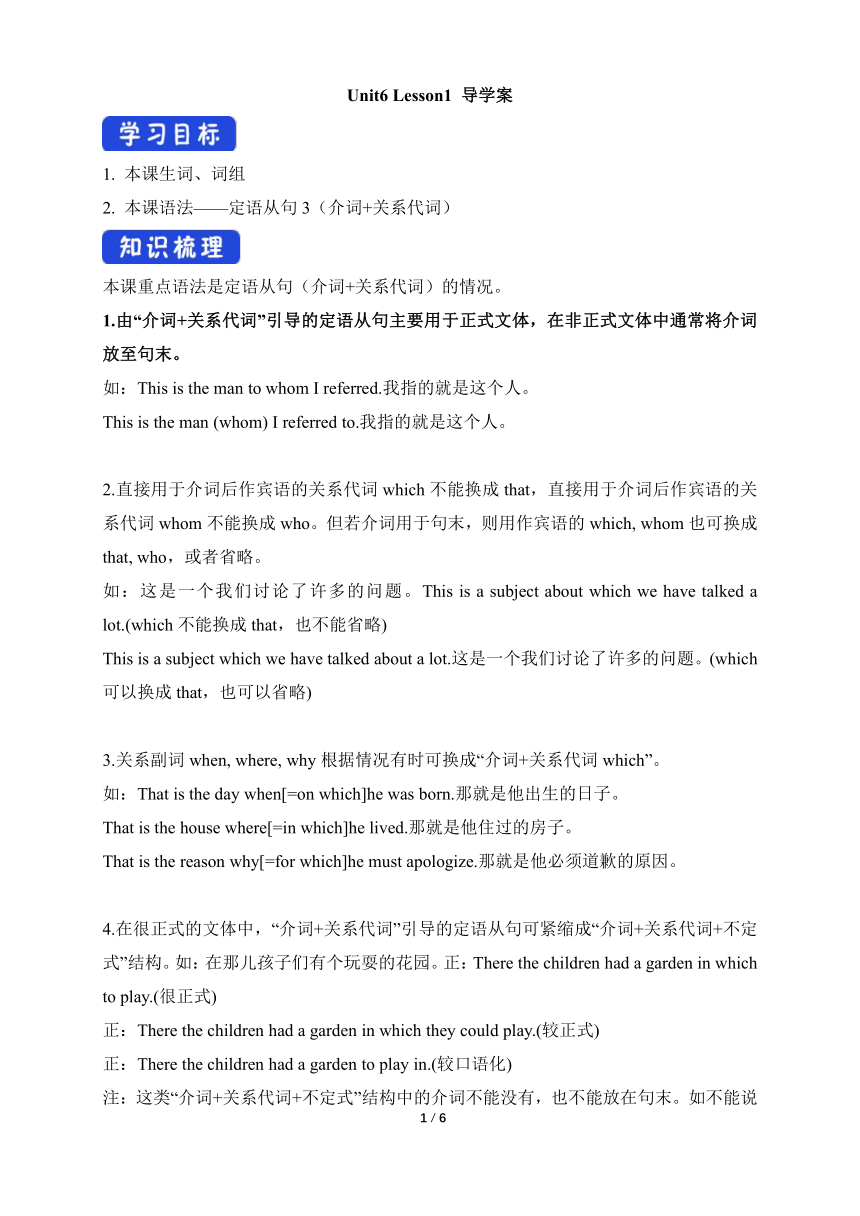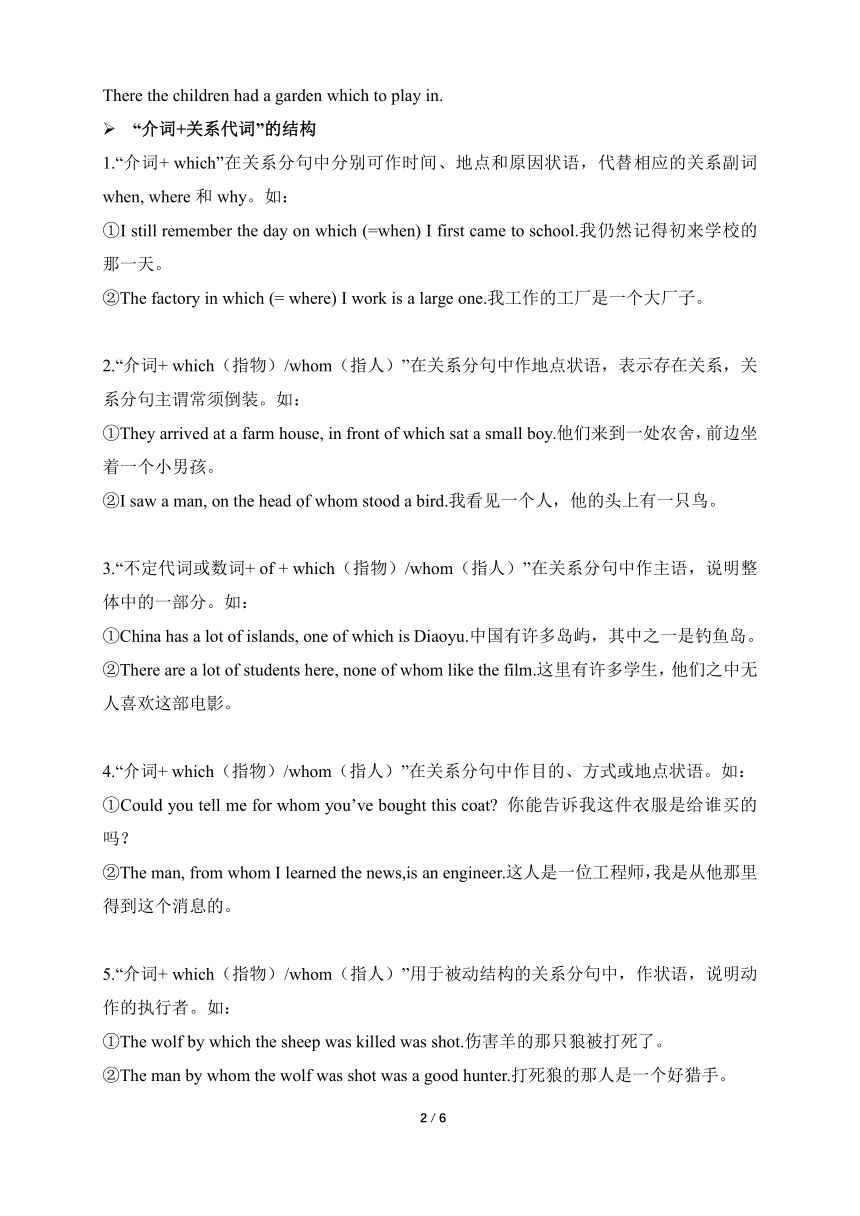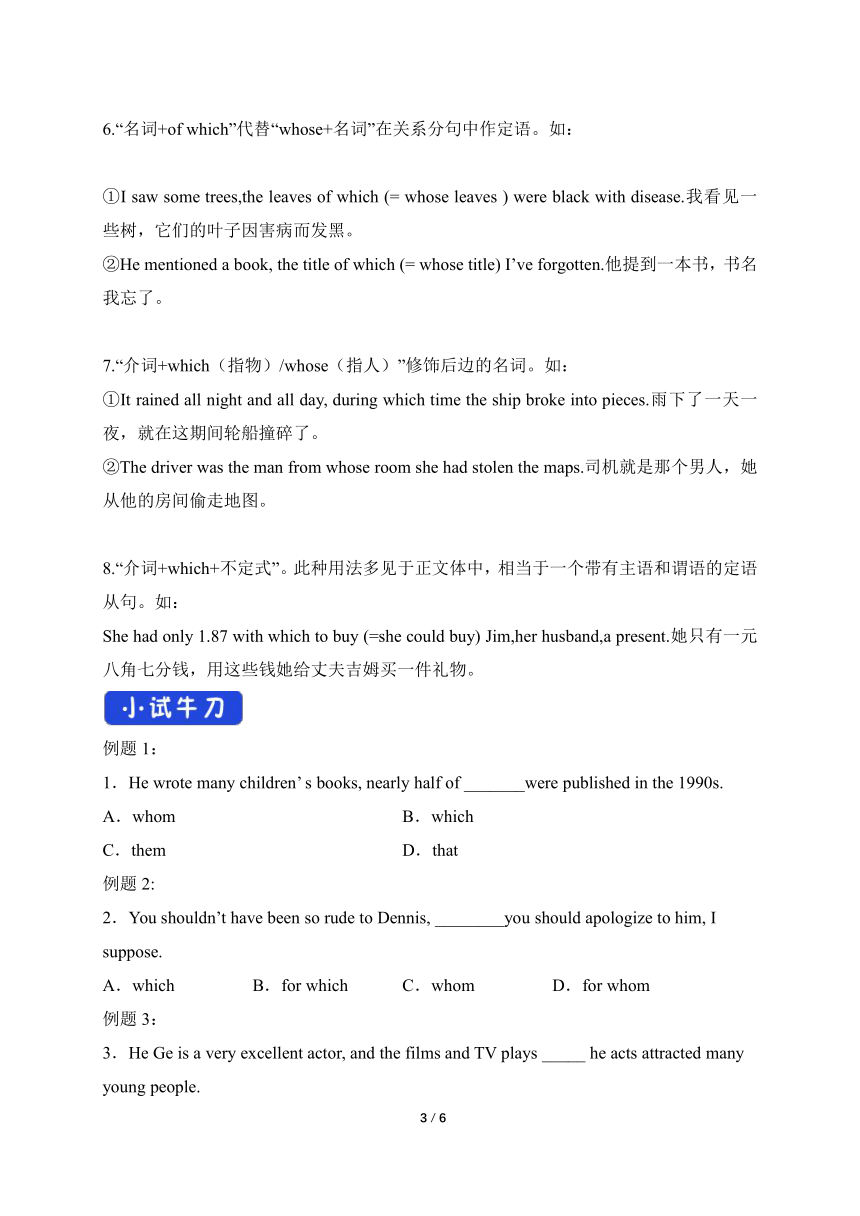北师大版(2019)必修第二册 Unit6The admirable Lesson1 A Medical Pioneer导学案(有答案)
文档属性
| 名称 | 北师大版(2019)必修第二册 Unit6The admirable Lesson1 A Medical Pioneer导学案(有答案) |  | |
| 格式 | docx | ||
| 文件大小 | 50.2KB | ||
| 资源类型 | 教案 | ||
| 版本资源 | 北师大版(2019) | ||
| 科目 | 英语 | ||
| 更新时间 | 2023-03-07 18:07:11 | ||
图片预览



文档简介
Unit6 Lesson1 导学案
本课生词、词组
本课语法——定语从句3(介词+关系代词)
本课重点语法是定语从句(介词+关系代词)的情况。
1.由“介词+关系代词”引导的定语从句主要用于正式文体,在非正式文体中通常将介词放至句末。
如:This is the man to whom I referred.我指的就是这个人。
This is the man (whom) I referred to.我指的就是这个人。
2.直接用于介词后作宾语的关系代词which不能换成that,直接用于介词后作宾语的关系代词whom不能换成who。但若介词用于句末,则用作宾语的which, whom也可换成that, who,或者省略。
如:这是一个我们讨论了许多的问题。This is a subject about which we have talked a lot.(which不能换成that,也不能省略)
This is a subject which we have talked about a lot.这是一个我们讨论了许多的问题。(which可以换成that,也可以省略)
3.关系副词when, where, why根据情况有时可换成“介词+关系代词which”。
如:That is the day when[=on which]he was born.那就是他出生的日子。
That is the house where[=in which]he lived.那就是他住过的房子。
That is the reason why[=for which]he must apologize.那就是他必须道歉的原因。
4.在很正式的文体中,“介词+关系代词”引导的定语从句可紧缩成“介词+关系代词+不定式”结构。如:在那儿孩子们有个玩耍的花园。正:There the children had a garden in which to play.(很正式)
正:There the children had a garden in which they could play.(较正式)
正:There the children had a garden to play in.(较口语化)
注:这类“介词+关系代词+不定式”结构中的介词不能没有,也不能放在句末。如不能说There the children had a garden which to play in.
“介词+关系代词”的结构
1.“介词+ which”在关系分句中分别可作时间、地点和原因状语,代替相应的关系副词when, where和why。如:
①I still remember the day on which (=when) I first came to school.我仍然记得初来学校的那一天。
②The factory in which (= where) I work is a large one.我工作的工厂是一个大厂子。
2.“介词+ which(指物)/whom(指人)”在关系分句中作地点状语,表示存在关系,关系分句主谓常须倒装。如:
①They arrived at a farm house, in front of which sat a small boy.他们来到一处农舍,前边坐着一个小男孩。
②I saw a man, on the head of whom stood a bird.我看见一个人,他的头上有一只鸟。
3.“不定代词或数词+ of + which(指物)/whom(指人)”在关系分句中作主语,说明整体中的一部分。如:
①China has a lot of islands, one of which is Diaoyu.中国有许多岛屿,其中之一是钓鱼岛。
②There are a lot of students here, none of whom like the film.这里有许多学生,他们之中无人喜欢这部电影。
4.“介词+ which(指物)/whom(指人)”在关系分句中作目的、方式或地点状语。如:
①Could you tell me for whom you’ve bought this coat 你能告诉我这件衣服是给谁买的吗?
②The man, from whom I learned the news,is an engineer.这人是一位工程师,我是从他那里得到这个消息的。
5.“介词+ which(指物)/whom(指人)”用于被动结构的关系分句中,作状语,说明动作的执行者。如:
①The wolf by which the sheep was killed was shot.伤害羊的那只狼被打死了。
②The man by whom the wolf was shot was a good hunter.打死狼的那人是一个好猎手。
6.“名词+of which”代替“whose+名词”在关系分句中作定语。如:
①I saw some trees,the leaves of which (= whose leaves ) were black with disease.我看见一些树,它们的叶子因害病而发黑。
②He mentioned a book, the title of which (= whose title) I’ve forgotten.他提到一本书,书名我忘了。
7.“介词+which(指物)/whose(指人)”修饰后边的名词。如:
①It rained all night and all day, during which time the ship broke into pieces.雨下了一天一夜,就在这期间轮船撞碎了。
②The driver was the man from whose room she had stolen the maps.司机就是那个男人,她从他的房间偷走地图。
8.“介词+which+不定式”。此种用法多见于正文体中,相当于一个带有主语和谓语的定语从句。如:
She had only 1.87 with which to buy (=she could buy) Jim,her husband,a present.她只有一元八角七分钱,用这些钱她给丈夫吉姆买一件礼物。
例题1:
1.He wrote many children’ s books, nearly half of _______were published in the 1990s.
A.whom B.which
C.them D.that
例题2:
2.You shouldn’t have been so rude to Dennis, ________you should apologize to him, I suppose.
A.which B.for which C.whom D.for whom
例题3:
3.He Ge is a very excellent actor, and the films and TV plays _____ he acts attracted many young people.
A.that B.in which C.with which D.what
根据要求写出对应汉语意思和词性
admirable ______________
infectious ______________
vomit ______________
vaccine ______________
award ______________
recognition ______________
academy______________ → (adj.) ______________
herb, ______________
recipe ______________
limit ______________→(adj.) ______________
staff ______________
fame ______________
influential ______________
conduct ______________
potential ______________
integrate ______________
一.单项选择(共5小题)
1. Although modern technology could help produce more crops, these terraces still mean a lot to the local people _____ traditions hold much value.
A.for whom B.of whom
C.for which D.of which
2.Professor Smith, for ________ work matters most, is devoted to his research work.
A.whose B.him C.whom D.what
3.It was in this school ______ name he will never forget ______he won the speaking competition about ____ the army and rescue workers made joint effort to return the earthquake disaster area to normal.
A.of which the; that; how B.where; where; why
C.whose; that; the reason D.its; that; how
4.Gun control is a subject Americans have argued for a long time.
A.of which B.with which C.about which D.into which
5.This is the building _______ the windows have been painted green.
A.whose B.that C.which D.of which
二. 语法填空
Tu Youyou,1. 84-year-old scientist, became the first female (女性)Chinese to 2. (win) a Nobel Prize in science on Oct,5. She 3. (share) the 2015 Nobel Prize for medicine because 4. the new medicine for malaria(疟疾). Tu was awarded (授予奖项)for”three firsts”. She was the first to bring artemisinin(青蒿素) to her team, the first to extract(提取) artemisinin that can stop malaria,5. the first to finish the experiment.
She first tried the medicine on 6. (she), because she wanted to make sure that it was safe (安全). “As the head of the group, I had the responsibility(责任).” The scientist spoke to CCTV about her work. Artemisinin is a gift for the world people. It has saved many people’s 7. (life). It comes from Chinese traditional medicine and now is a good way to treat malaria. Tu Youyou expects Chinese medicine to help 8. (many) people all over the world.
We can learn a lot from Tu Youyou. We should do something useful for people. If we want to be 9. (success), we should keep on 10. (work) hard with our group and never give up.
参考答案:
小试牛刀:BBB
达标检测:
单项选择 ACACD
语法填空
1.an 2.win 3.shared 4.of 5.and
6.herself 7.lives 8.more 9.successful 10.working
6 / 6
本课生词、词组
本课语法——定语从句3(介词+关系代词)
本课重点语法是定语从句(介词+关系代词)的情况。
1.由“介词+关系代词”引导的定语从句主要用于正式文体,在非正式文体中通常将介词放至句末。
如:This is the man to whom I referred.我指的就是这个人。
This is the man (whom) I referred to.我指的就是这个人。
2.直接用于介词后作宾语的关系代词which不能换成that,直接用于介词后作宾语的关系代词whom不能换成who。但若介词用于句末,则用作宾语的which, whom也可换成that, who,或者省略。
如:这是一个我们讨论了许多的问题。This is a subject about which we have talked a lot.(which不能换成that,也不能省略)
This is a subject which we have talked about a lot.这是一个我们讨论了许多的问题。(which可以换成that,也可以省略)
3.关系副词when, where, why根据情况有时可换成“介词+关系代词which”。
如:That is the day when[=on which]he was born.那就是他出生的日子。
That is the house where[=in which]he lived.那就是他住过的房子。
That is the reason why[=for which]he must apologize.那就是他必须道歉的原因。
4.在很正式的文体中,“介词+关系代词”引导的定语从句可紧缩成“介词+关系代词+不定式”结构。如:在那儿孩子们有个玩耍的花园。正:There the children had a garden in which to play.(很正式)
正:There the children had a garden in which they could play.(较正式)
正:There the children had a garden to play in.(较口语化)
注:这类“介词+关系代词+不定式”结构中的介词不能没有,也不能放在句末。如不能说There the children had a garden which to play in.
“介词+关系代词”的结构
1.“介词+ which”在关系分句中分别可作时间、地点和原因状语,代替相应的关系副词when, where和why。如:
①I still remember the day on which (=when) I first came to school.我仍然记得初来学校的那一天。
②The factory in which (= where) I work is a large one.我工作的工厂是一个大厂子。
2.“介词+ which(指物)/whom(指人)”在关系分句中作地点状语,表示存在关系,关系分句主谓常须倒装。如:
①They arrived at a farm house, in front of which sat a small boy.他们来到一处农舍,前边坐着一个小男孩。
②I saw a man, on the head of whom stood a bird.我看见一个人,他的头上有一只鸟。
3.“不定代词或数词+ of + which(指物)/whom(指人)”在关系分句中作主语,说明整体中的一部分。如:
①China has a lot of islands, one of which is Diaoyu.中国有许多岛屿,其中之一是钓鱼岛。
②There are a lot of students here, none of whom like the film.这里有许多学生,他们之中无人喜欢这部电影。
4.“介词+ which(指物)/whom(指人)”在关系分句中作目的、方式或地点状语。如:
①Could you tell me for whom you’ve bought this coat 你能告诉我这件衣服是给谁买的吗?
②The man, from whom I learned the news,is an engineer.这人是一位工程师,我是从他那里得到这个消息的。
5.“介词+ which(指物)/whom(指人)”用于被动结构的关系分句中,作状语,说明动作的执行者。如:
①The wolf by which the sheep was killed was shot.伤害羊的那只狼被打死了。
②The man by whom the wolf was shot was a good hunter.打死狼的那人是一个好猎手。
6.“名词+of which”代替“whose+名词”在关系分句中作定语。如:
①I saw some trees,the leaves of which (= whose leaves ) were black with disease.我看见一些树,它们的叶子因害病而发黑。
②He mentioned a book, the title of which (= whose title) I’ve forgotten.他提到一本书,书名我忘了。
7.“介词+which(指物)/whose(指人)”修饰后边的名词。如:
①It rained all night and all day, during which time the ship broke into pieces.雨下了一天一夜,就在这期间轮船撞碎了。
②The driver was the man from whose room she had stolen the maps.司机就是那个男人,她从他的房间偷走地图。
8.“介词+which+不定式”。此种用法多见于正文体中,相当于一个带有主语和谓语的定语从句。如:
She had only 1.87 with which to buy (=she could buy) Jim,her husband,a present.她只有一元八角七分钱,用这些钱她给丈夫吉姆买一件礼物。
例题1:
1.He wrote many children’ s books, nearly half of _______were published in the 1990s.
A.whom B.which
C.them D.that
例题2:
2.You shouldn’t have been so rude to Dennis, ________you should apologize to him, I suppose.
A.which B.for which C.whom D.for whom
例题3:
3.He Ge is a very excellent actor, and the films and TV plays _____ he acts attracted many young people.
A.that B.in which C.with which D.what
根据要求写出对应汉语意思和词性
admirable ______________
infectious ______________
vomit ______________
vaccine ______________
award ______________
recognition ______________
academy______________ → (adj.) ______________
herb, ______________
recipe ______________
limit ______________→(adj.) ______________
staff ______________
fame ______________
influential ______________
conduct ______________
potential ______________
integrate ______________
一.单项选择(共5小题)
1. Although modern technology could help produce more crops, these terraces still mean a lot to the local people _____ traditions hold much value.
A.for whom B.of whom
C.for which D.of which
2.Professor Smith, for ________ work matters most, is devoted to his research work.
A.whose B.him C.whom D.what
3.It was in this school ______ name he will never forget ______he won the speaking competition about ____ the army and rescue workers made joint effort to return the earthquake disaster area to normal.
A.of which the; that; how B.where; where; why
C.whose; that; the reason D.its; that; how
4.Gun control is a subject Americans have argued for a long time.
A.of which B.with which C.about which D.into which
5.This is the building _______ the windows have been painted green.
A.whose B.that C.which D.of which
二. 语法填空
Tu Youyou,1. 84-year-old scientist, became the first female (女性)Chinese to 2. (win) a Nobel Prize in science on Oct,5. She 3. (share) the 2015 Nobel Prize for medicine because 4. the new medicine for malaria(疟疾). Tu was awarded (授予奖项)for”three firsts”. She was the first to bring artemisinin(青蒿素) to her team, the first to extract(提取) artemisinin that can stop malaria,5. the first to finish the experiment.
She first tried the medicine on 6. (she), because she wanted to make sure that it was safe (安全). “As the head of the group, I had the responsibility(责任).” The scientist spoke to CCTV about her work. Artemisinin is a gift for the world people. It has saved many people’s 7. (life). It comes from Chinese traditional medicine and now is a good way to treat malaria. Tu Youyou expects Chinese medicine to help 8. (many) people all over the world.
We can learn a lot from Tu Youyou. We should do something useful for people. If we want to be 9. (success), we should keep on 10. (work) hard with our group and never give up.
参考答案:
小试牛刀:BBB
达标检测:
单项选择 ACACD
语法填空
1.an 2.win 3.shared 4.of 5.and
6.herself 7.lives 8.more 9.successful 10.working
6 / 6
同课章节目录
- Unit 4 Information technology
- Lesson 1 Avatars
- Lesson 2 Apps
- Lesson 3 Internet and Friendships
- Unit 5 Humans and nature
- Lesson 1 A Sea Story
- Lesson 2 Professional Rescue Team
- Lesson 3 Race to the Pole
- Unit 6 The admirable
- Lesson 1 A Medical Pioneer
- Lesson 2 History Makers
- Lesson 3 The Superhero Behind Superman
